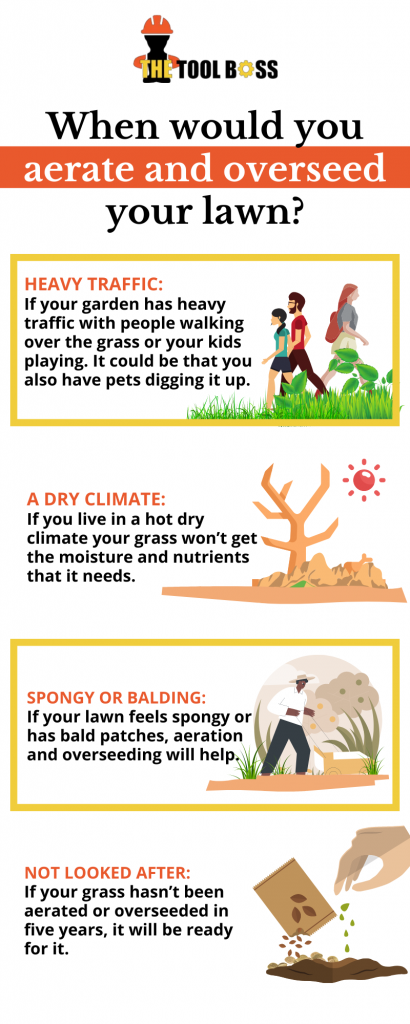They say that the grass is greener on the other side, but that’s not true if you are diligent with your lawn care.
By using aeration and overseeding your lawn at the right time, you will have a healthy-looking, thick, lush green lawn that will be the envy of friends and neighbors.
If your grass looks tired and a little thin or has had lots of use from the kids or pets, aerating and overseeding your lawn can give it the new lease of life it needs.
It can take a lot of time and effort to get the beautiful lush lawn you want, but the end result is worth it. We’ll let you know why you should aerate and overseed your lawn and when is the best time to do this. The results will leave you lost for words.
We explore:
- Why Aerating Helps Lawns
- What Are the Benefits of Overseeding?
- Will Core Aeration and Overseeding Fix All Lawn Problems?
- So, How Do You Care for Your Lawn Following Aeration and Seeding?

Why Aerating Helps Lawns
Aerating your lawn helps to produce strong, healthy roots and provide your grass and soil with more oxygen and nutrients.
Lawn aeration is quite literally poking holes in your lawn with a rake.
The holes that you make in the turf allow water to get deeper into the soil, soaking the grass’s roots and helping it grow to make your lawn thick and strong.
Aeration resolves the problem of heavy soil compaction and will also prevent thatch from becoming an issue.
You should aerate your lawn if any of the following issues are familiar:
- If your garden has heavy foot traffic and the soil has become compacted. It could be that it’s been used as a walkway, by children playing in the garden, or if you have pets.
- Your grass may dry out quickly or have a spongy feel. This could be the start of a thatch problem. Aerating won’t always stop the issue, but it will help prevent it from getting worse.
- If your home is a newly constructed house, the soil may have been compacted by construction workers trampling it every day. It probably just had a layer of topsoil added to the compacted soil, which won’t help your grass to grow.
- You live in a dry climate where the soil doesn’t get any nutrients for the roots to soak up, or you are experiencing a drought.
- If your soil has a fine layer of soil added over the top of the existing coarse ground. The water is then held in the top layer and can’t get down into the roots.
Timing the Aeration
Make sure that you aerate and overseed your lawn at the most suitable time as this is when it will benefit the most from the treatment. The best time to aerate your lawn is during the growing season so that it can repair itself easily and quickly.
The timings will differ between warm-season grasses and cool-season grasses due to the type of climate and soil temperatures. For cool-season grasses, the best time to aerate is generally early spring or fall, and for warm-season grasses, the best time to aerate is late spring.
You should avoid aerating your grass when it is dormant. Aerating it when dormant may encourage weeds to grow, which is not what you’re aiming for.
What Are the Benefits of Overseeding?
Overseeding is planting new grass seed on your existing lawn to fill out any thin patches. Overseeding should be done across the whole lawn with more grass seeds applied to the turf that looks a little thinner than the rest.
Overseeding is a great way of giving your lawn an overhaul, improving the density, and enhancing the color of your grass.
The overseeding process also makes your grass stronger and able to ward off weeds and pests.
Overseeding and aeration will also help to reduce erosion by making sure that the water goes to the base of the grass’s roots. The roots will then hold onto the nutrients they require, reducing soil loss.
You should overseed if you notice the following issues on your lawn:
- Your grass looks thin and balding in some areas.
- Your grass has yellow or brown blotchy patches.
- Your grass looks like it’s damaged.
- Your grass looks tired and old and needs freshening up.
- Your lawn hasn’t been overseeded in five years.
By maintaining your lawn and keeping it strong and healthy, you will need far fewer treatments than you would with an uncared for lawn. Good maintenance will eliminate the need for any strong chemical fertilizers or pesticides to correct any problems.
Overseeding should be combined with the core aeration of your lawn for the best results.
The best time to overseed your lawn will depend on the type of grass you have. It will differ slightly for warm-season grasses and cool season grasses.
Warm-season grasses benefit from overseeding in late spring as this is when warm-season grass is growing actively. For cool-season grass, the best time to overseed them would be late summer or early fall when there’s more moisture in the soil.
Will Core Aeration and Overseeding Fix All Lawn Problems?
The lawn aeration process will get oxygen, water and nutrients down to the roots of your grass and overseeding will improve the density and appearance of your lawn.
This process will also help eradicate other problems that your lawn may have such as compacting or mild lawn pest issues and make it more resilient to harm in the future.
By looking after your lawn properly by mowing it regularly, applying weed and feed at the right time, and watering it when needed, and spending a little time caring for it, you will reap the benefits.
However, if your lawn has been left uncared for, for several years, it may take much more than core aeration and overseeding to get it back to its best.
If you have more serious issues, such as thick thatching, the roots of your overseed grass won’t be able to penetrate the earth to establish and grow. In this case, you should dethatch your lawn first.
We have a helpful guide on when to use a dethatcher, scarifier or a pwer rake, depending upon conditions.
If you have a weed infestation, a herbicide may be required to get rid of them first, before you aerate and overseed.
Your lawn may even need to be completely stripped back to basics—starting from scratch.
That’s why you must implement lawn care from day one, rather than when the problem becomes too big.
So, How Do You Care for Your Lawn Following Aeration and Seeding?
Once you have completed the aerate and overseed process, how will you care for your lawn and keep it in the best condition?
For the first two weeks after the treatment, you should make sure that the grass and soil are kept moist at all times. The seeds and the roots both need this moisture to grow strong. You need to ensure that you don’t overwater it or spray it too powerfully as the seeds may wash away.
From week three, your grass seed should have started to germinate and grow. You need to continue to water the grass, but should reduce this slightly to three to four times per week.
The grass will need to be mowed but make sure that you keep your mower on a high level and let the grass dry out before cutting.
Four weeks after the aeration and overseeding treatment, your new grass will now be established. You should continue to water the lawn around twice per week and mow the grass when needed.
Care should still be taken when mowing, and be careful not to cut the grass too short.
By this time, you should have a beautiful lawn that you could only dream of at the start of the process.
Conclusion
Your lawn needs constant care throughout the year, especially in the spring and fall when it’s growing quickly.
As soon as you start to see any issues with your grass, you should get to work on resolving them quickly. This will save you time and effort later in the season.
We believe that aeration is the best option to give your grass and soil everything it needs to grow strong and healthy.
Aerating the ground will also help combat some issues seen with compacted soil from heavy foot traffic.
Overseeding your grass will give it a whole new lease of life. It will go from being a worn down, tired, patchy-looking lawn to a healthy, lush, vibrant green lawn in a matter of a few weeks.
It may appear to be hard work getting your lawn looking its best, but believe us when we say that it’ll definitely be worth it!
